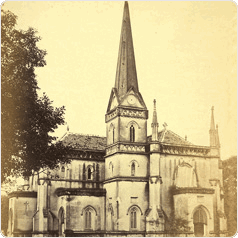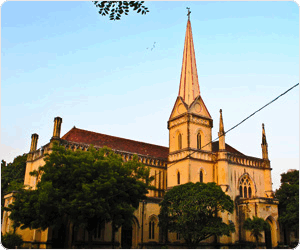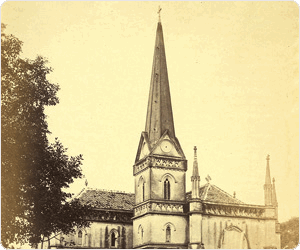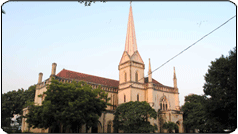
Christ Church
Christians of the city celebrating Christmas will be delighted to learn that Lucknow has the distinction of having the first English church in Northern India and the third in the country, if 1810 as the year of erection of St. Mary's Church in the British Residency, mentioned by Sidney Hay in Historic Lucknow (first published in 1939) as well as Philip Davies in his Guide to Monuments of India, is correct.
The advent of Christians in India dates back to year 52 AD with the landing of St. Thomas in Kerala. A Bishop of India is also mentioned in 325 AD, but the first European church was built in Cochin in 1510 (Vasco da Gama was initially buried here in 1524 ; but later his remains were moved to Lisbon where they were buried again in 1538).
The British built their first church in India at Madras (Chennai) in 1680, (it was also named St. Mary's Church), followed by another built in Calcutta in 1770, the St. John's Church. With 1810 as the year of construction of St. Mary's Church in the British Residency, Lucknow naturally becomes the third city, as no other English church was built between 1770 and 1819.
However, since Rosie Llewellyn Jones in her book A Fatal Friendship mentions the year 1837 while giving the cost of the Gothic church at Residency, a doubt has been created. In her words 'The Gothic church in the Lucknow Residency area cost only Pound 540 in 1837, with further Pound 70 spent on the gates, the walls, the railings and the outbuildings'. The buildings in the Residency belonged to the Nawabs of Awadh, who built them for their honoured guests, the Resident and the staff of the British East India Company. It is not clear if the Nawab paid for the construction of this church or did the Company pay for it.

Built in the Gothic style with twenty steeples on its top, the church had a cross mounted over the entrance on the north. It had a capacity of a hundred and thirty persons. The church was under fire from the rebels (freedom fighters), the heaviest of which were on July 31 and August 5, 1857. The British were besieged and used the church as a store-house for ghee. At one stage they seriously considered blowing up the church but gave up the idea to save expenditure of gunpowder, which was scarce.
In India, earlier it was not the practice to have burial grounds attached to the church, but in the difficult circumstances at the Residency, the garden of the church was converted into a cemetery. The first to be buried there were victims of the surprise attack by the rebels at Mandiaon cantonment on May 30, 1857.
The magnificent structure of St. Mary's Church was destroyed during 1857-1858 conflict. A sketch of the church was made by M.C.Mecham (in 1858) and a tiny model of the Church may be seen in the Residency Model room.
Prayer services including mass for Christmas were held thereafter in the tomb of Nawab Saadat Ali Khan at Khas Bazaar and later on at the Imambara Sibtainabad (Built on the grave of the fourth king of Awadh, Amjad Ali Shah). Maulana Agha Mehdi in Taareekh-e~Lakhnau cites a report of the Darogha of Nazal, Karamat Hussain given to the Deputy Commissioner in 1859 in this respect. Hay also confirms this fact in her book.

In 1860, the church known today as Christ Church, situated towards the east of G.P.O. in Hazrat gunj, was built as a memorial to the dead of the Mutiny for their unparalleled bravery, it was originally known as the Church of England and was designed by General Hutchinson. The interior walls of the church still retain a iarge number of marble tablets and polished brass plaques erected in the memory of the British army officers, civilians and clergy that died during the conflict. One marble tablet in the transept is dedicated to James Grant Thomson, Deputy Commissioner of Muhamadee, who was 'murdered by the mutineers at Aurangabad in Oudh, June 5,h 1857' according to the inscription. Another is dedicated to Revered Henry Polehampton. The church was enlarged and improved in 1904. It has the characteristic plan of construction in the form of a cross - the symbol of Christ's sacrifice for mankind. The transepts on the two sides of the nave symbolise the arms while chancel represents ihe head.
A belfry appears attached to the transept on the south. The bell tower has a spire pointing towards the sky with a cross at the pinnacle. The cross is reported to have twisted due to an earthquake in 1933.
One of the most impressive art pieces that one finds in this church are the stained glass trip-tych murals representing the iconic figures of the Christian faith that have been beautifully painted (by some European artist).
The larger one provides the background for the altar on the east while the comparitively smaller one appears on the west, above the main entrance. Both the three panelled murals have painted figures framed within intersecting arches crowning the main painting.
Source:
Hindustan Times, A Time in History
Wednesday 23.12.1998 — Early Churches of Lucknow

